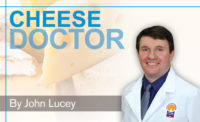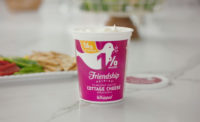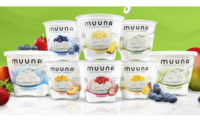
Cottage on the Cusp
by Julie Cook Ramirez
Contributing Editor
New investments in products and promotions have cottage cheese makers feeling uncharacteristically upbeat.
Could the long-awaited,
long-hoped-for revival of cottage cheese be just around the corner?
A number of cottage cheese makers are hopeful its time
has finally come. And they are willing to put their money where their
mouths are — investing in new products, new technology, and new
promotions, all designed to give cottage cheese a much-needed boost.
Interestingly, two of the category’s largest
players — Dallas-based Dean Foods Co. and Northfield, Ill.-based
Kraft Foods Inc. — have taken a page from yogurt’s playbook and
targeted their efforts in the pre- and probiotics arena. Kraft rolled out
LiveActive Cottage Cheese for Digestive Health last April under its
Breakstone’s and Knudsen’s brands. Boasting 3 grams of
prebiotic dietary fiber in each serving, LiveActive is said to be the first
cottage cheese to contain inulin, a prebiotic fiber source derived from the
chicory root. Health benefits of inulin include alleviating common
digestive troubles while aiding in calcium absorption.
“Maintaining a healthy digestive system is
essential to a person’s health and well-being,” says Jason
Hecker, Kraft’s brand manager for cottage cheese. “Kraft is
dedicated to meeting the growing demand for nutritional benefits in food
products, and LiveActive Cottage Cheese is just one example of how we are
working to provide healthier options for our consumers.”
Dean, meanwhile, rolled out a new probiotic cottage
cheese containing Lactobacillus acidophilus, Bifidobacterium and Lactobacillus
casei. The product is available throughout the Upper Midwest under
Dean’s three flagship brands: Dean Foods, Country Fresh and Land
O’Lakes.
According to David Haley, regional director of
marketing for Dean’s Midwest Region, the product was developed out of
a desire to add value to the cottage cheese product. Once the concept was
finalized, Haley says, a great deal of work went into ensuring that the
resulting product possessed the same taste and mouth feel as traditional
cottage cheese, while the cultures remained alive throughout its entire
shelf-life.
“We recognized that we needed to get people to
taste the product, so one of our main drivers was in-store demos with
educational materials about probiotics,” Haley says. “Not only
did people find out it doesn’t taste different, they found out it
costs the same as their regular cottage cheese and has the added
benefits.”
| TOP 10 Cottage cheese BRANDS* | ||||
| $SALES (IN MILLIONS) | % CHANGE VS. YEAR AGO | UNIT SALES (In Millions) | % CHANGE VS. YEAR AGO | |
| Total Category | $884.6 | 0.9% | 408.8 | -2.7% |
| Private Label | 324.2 | 2.1 | 159.2 | -2.3 |
| Breakstone | 96.2 | 8.6 | 35.4 | 5.3 |
| Knudsen | 69.1 | -6.8 | 24.7 | -10.0 |
| Breakstone Cottage Dbls | 37.3 | 4.6 | 35.2 | 5.7 |
| Friendship | 27.1 | -1.5 | 12.7 | -5.7 |
| Dean's | 27.1 | -3.3 | 11.4 | -7.4 |
| Hood | 23.8 | -0.5 | 9.8 | -6.6 |
| Prairie Farms | 17.2 | -4.7 | 8.1 | -8.1 |
| Knudsen Cottage Doubles | 15.3 | 13.3 | 12.6 | 15.8 |
| Darigold | 12.7 | 3.4 | 6.0 | -3.9 |
| * Total sales in supermarkets, drug stores and mass merchandisers, excluding Wal-Mart, for the 52-week period ending September 9, 2007. SOURCE: Information Resources Inc. |
||||
Like the Kraft product, Dean’s probiotic cottage cheese is intended to aid in digestion. Does that mean Dean Foods is seeking to score an Activia-type home run for the cottage cheese category? “We don’t want to say we copied a certain yogurt manufacturer’s stuff, but we looked at what some of the yogurt companies were putting on their packages and came to the conclusion that it’s all about digestion,” Haley says.
Courting Consumers
It’s also about attracting a younger, more
active consumer, something the category sorely needs if it is going to
survive. Long saddled with the reputation of being an antiquated
“diet food,” cottage cheese is widely recognized as a category
whose consumer base has “one foot in the grave and the other on a
banana peel,” according to Jed Davis, director of marketing, Cabot
Creamery Cooperative, Cabot, Vt.
With the new healthy eating focus in many school
districts across the country, the school lunch arena presents a significant
opportunity for cottage cheese to capture a whole new generation of
consumers. “If we could get cottage cheese added as a dairy serving
on school menus, that would be a home run for the category,” Haley
says. “Right now, however, I’m not aware of too many schools
that have done that.”
Haley concedes that schools’ hesitance to open
the door to cottage cheese could be due to kids’ disdain for the
product. After all, he says, his own 13-year-old daughter "looks at
cottage cheese and says, ‘How can you eat that
stuff?"
When it comes to securing cottage cheese a spot on the
school lunch tray, Penny Baker, director of marketing for Orrville,
Ohio-based Smith Dairy Products Co., admits she’s at a loss. However,
she suspects that the answer lies in the area of flavored cottage cheese
with better packaging.
“It’s got to come in the form of
single-serve containers, rather than just a dollop of cottage cheese from a
foodservice line on a tray,” she says. “The other element would
be cottage cheese with fruit, cottage cheese salsa, flavored cottage cheese
— line extensions to go past traditional cottage cheese.”
For its part, Smith Dairy has focused its marketing
efforts on promoting cottage cheese as an ingredient. During the first
quarter of 2007, the company sponsored the Smith’s Cash Cow Cottage
Cheese Recipe Contest. Consumers were invited to submit their most original
and creative cottage cheese recipes for appetizers, main dishes and
desserts.
Not only did the contest result in a 20 percent
increase in retail sales during the 12-week promotional period, but it also
gave the company some valuable insight into just how consumers are using
their product in their own kitchens.
Looking forward, Baker reveals that Smith Dairy is
“looking into” probiotic and prebiotic products. Meanwhile, Des
Moines, Iowa-based Anderson Erickson Dairy is merely keeping an eye on such
activities. At this point, company president Miriam Erickson Brown says
AE’s core cottage cheese business has proven so successful, she
doubts such R&D efforts would result in much of the way of a payoff.
In Phoenix, meanwhile, Shamrock Farms continues to look
for ways to breathe new life into the ailing category. For the time being,
the question remains just exactly how to go about doing so.
“Cottage cheese is on our radar screen in terms
of how can we innovate,” says Sandy Kelly, director of marketing,
Shamrock Farms, Phoenix. “Is it packaging? Is it product development?
I think it’s all of the above.”
Still, there’s no denying that the tide seems to
be turning in terms of the amount of optimism surrounding the cottage
cheese category. Further evidence that Dean is feeling bullish about
cottage cheese came to light this spring when the company paid $130 million
for Jericho, N.Y.-based Friendship Dairies Inc., a 90-year-old privately
held maker of cottage cheese and other cultured products.
Then there’s Dallas-based Daisy Brand. A
dedicated manufacturer of sour cream for more than 75 years, Daisy recently
entered the cottage cheese business. The privately held company declined to
comment for this article, but the product is being promoted as “a
creamy, delicious way to start your morning” and “a quick and
easy way to lighten up your day.”
So far, all the enthusiasm with regard to cottage
cheese has yet to result in much of an increase in overall category sales.
But cottage cheese makers are upbeat about the
category’s future prospects, especially in light of recent
innovations. “I think people will gradually start coming back to
cottage cheese once they realize it’s low-fat and it’s got
loads of calcium and protein,” Haley says. “When you add
value-added benefits, like probiotics, to it, you’ve got a real
winner.”
Julie Cook Ramirez is a freelance journalist based in
the Chicago area.


